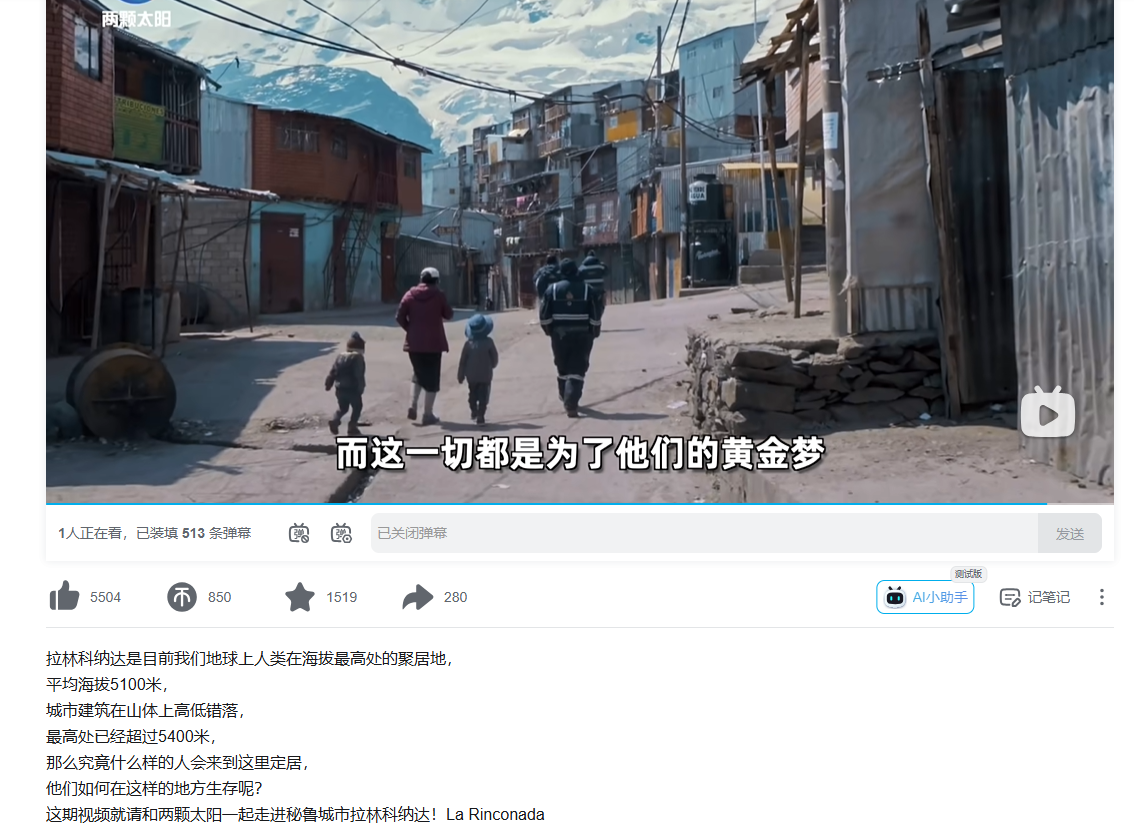拉林科纳达:安第斯山脉上的黄金小镇
中文:拉林科纳达是安第斯山脉上因黄金而生的特殊城镇,以 “世界最高永久居住地” 的地理标签与单一矿业经济为核心特征。它保留了原始的安第斯印第安文化,却因极端环境与资源依赖面临贫困、安全、环境等多重挑战。作为秘鲁经济链条中的微小节点,它无国际影响力,仅通过黄金贸易与全球市场间接关联。对于环球旅行者而言,它并非传统旅游目的地,却因独特的高原矿业生态,成为观察极端环境下人类生存状态的小众样本。(注:文档
目录标题
- 拉林科纳达:安第斯山脉上的黄金小镇 La Rinconada: The Gold Town in the Andes Mountains
-
- 一、地理与人口 Geography and Population
- 二、历史脉络 Historical Context
- 三、政治体制 Political System
- 四、经济与产业 Economy and Industry
- 五、文化与社会 Culture and Society
- 六、科技与创新 Technology and Innovation
- 七、环境与可持续发展 Environment and Sustainability
- 八、社会挑战 Social Challenges
- 九、外交与国际地位 Diplomatic Status
- 十、地方特色与旅游 Local Features and Tourism
- 总结 Conclusion
拉林科纳达:安第斯山脉上的黄金小镇 La Rinconada: The Gold Town in the Andes Mountains

7分钟游遍拉林科纳达:人们为何前赴后继来到5100米海拔生存?
一、地理与人口 Geography and Population
地理位置 Geographic Location
-
中文:位于秘鲁东南部安第斯山脉腹地,靠近玻利维亚边境(南纬 15°30′,西经 69°20′),海拔约 5100-5200 米,是全球海拔最高的永久居住地之一。属高原寒带气候,年平均气温 - 2℃至 5℃,昼夜温差超 20℃,降水稀少(年降水量约 200 毫米),多强风与霜冻。
-
English: Located in the hinterland of the Andes Mountains in southeastern Peru, near the border with Bolivia (15°30′S, 69°20′W), with an altitude of approximately 5,100-5,200 meters, making it one of the world’s highest permanent human settlements. Features an alpine tundra climate, with an average annual temperature of -2℃ to 5℃, a daily temperature difference of over 20℃, scarce precipitation (about 200 mm annually), and frequent strong winds and frost.
人口与首都 Population and Capital Status
-
中文:秘鲁普诺大区(Puno Region)管辖下的矿业城镇,非秘鲁首都(首都为利马)。因矿业人口流动性大,人口数据波动显著,2024 年预估常住人口 3-5 万,主要为矿工及家属,其中约 60% 来自秘鲁其他地区,少数为玻利维亚移民。城镇总面积约 4.5 平方千米,沿安第斯山脉陡坡分布,无明确城市边界。
-
English: A mining town under the jurisdiction of Puno Region, Peru (not the national capital; Lima is the capital). Due to high population mobility driven by mining, population data fluctuates significantly, with an estimated permanent population of 30,000-50,000 in 2024, mainly miners and their families. Approximately 60% are migrants from other regions of Peru, and a small number are Bolivian immigrants. Covers an area of about 4.5 km², distributed along the steep slopes of the Andes Mountains with no clear urban boundaries.
二、历史脉络 Historical Context
古代与中世纪 Ancient and Medieval Periods
-
中文:16 世纪前为克丘亚印第安部落的游牧与半游牧区域,部落以高山畜牧业(饲养羊驼、骆马)和小规模马铃薯种植为生,无固定聚居点,文化以口头传承的安第斯神话、传统纺织技艺为特色,受印加帝国间接影响。
-
English: Before the 16th century, it was a nomadic and semi-nomadic area of the Quechua indigenous tribes, who lived on high-altitude animal husbandry (raising alpacas and llamas) and small-scale potato cultivation. No fixed settlements existed; their culture was characterized by orally transmitted Andean myths and traditional textile techniques, indirectly influenced by the Inca Empire.
近代与现代 Modern Period
-
中文:19 世纪末秘鲁政府开始勘探当地金矿,但因高海拔与交通闭塞未大规模开发;20 世纪 80 年代后,秘鲁矿业政策放宽,小型采矿者涌入,逐渐形成临时聚居点;2000 年后因黄金价格上涨,人口快速增加,逐步发展为永久城镇,但基础设施始终滞后;2020 年以来受全球黄金价格波动影响,人口出现小幅流失。
-
English: In the late 19th century, the Peruvian government began exploring local gold mines, but large-scale development was hindered by high altitude and poor transportation; after the 1980s, Peru relaxed its mining policies, attracting small-scale miners and gradually forming temporary settlements; after 2000, the population increased rapidly due to rising gold prices, gradually developing into a permanent town, but infrastructure remained underdeveloped; since 2020, the population has experienced a slight decline due to fluctuations in global gold prices.
三、政治体制 Political System
联邦总统制 Presidential System
-
中文:秘鲁实行总统制共和政体,三权分立(立法、行政、司法)。总统为国家元首兼政府首脑,由全国直选产生,任期 5 年,不得连任(2021 年宪法修正案后),需年满 35 岁且为秘鲁出生公民。拉林科纳达作为城镇,无独立政治权限,受普诺大区政府及当地市政厅管辖,市政官员由区域选举产生,任期 4 年。
-
English: Peru adopts a presidential republican system with separation of powers (legislative, executive, judicial). The president is both head of state and government, elected by national direct vote for a 5-year term (no re-election after the 2021 constitutional amendment), requiring Peruvian birth and age 35+. As a town, La Rinconada has no independent political authority; it is governed by the Puno Regional Government and the local municipal government, with municipal officials elected regionally for 4-year terms.
行政区划 Administrative Division
-
中文:隶属于秘鲁普诺大区的普诺省(Puno Province),无正式行政区划分(如街区),城镇沿金矿开采区自然分布,主要分为采矿区(如 San Juan 矿场周边)、居民聚居区(多为临时搭建的木屋群落)及少量商业服务区(集中在城镇中心一条主街道),行政管控因地理偏远相对薄弱。
-
English: Subordinate to Puno Province of Puno Region, Peru, with no formal administrative divisions (e.g., neighborhoods). The town is naturally distributed along gold mining areas, mainly divided into mining zones (e.g., around the San Juan Mine), residential areas (mostly temporary wooden house clusters), and a small number of commercial service areas (concentrated on a main street in the town center). Administrative control is relatively weak due to geographical remoteness.
四、经济与产业 Economy and Industry
经济概况 Economic Overview
-
中文:经济完全依赖金矿开采,为典型的 “单一资源型经济”,2023 年当地矿业产值占城镇经济总量的 95% 以上,无制造业与规模化农业。采矿模式以小型、非正式开采为主(约 80% 为家庭式或小型合作社采矿),采用传统手工与简易机械结合的方式,生产效率低。居民收入高度依赖黄金产量与国际金价,2024 年因金价稳定,人均月收入约 200-300 美元,贫困率仍超 60%。
-
English: The economy is completely dependent on gold mining, a typical “single-resource economy”. In 2023, local mining output accounted for over 95% of the town’s total economic output, with no manufacturing or large-scale agriculture. Mining is dominated by small-scale, informal operations (about 80% are family-run or small cooperative mines), using a combination of traditional manual labor and simple machinery, resulting in low production efficiency. Residents’ income is highly dependent on gold output and international gold prices; in 2024, due to stable gold prices, the average monthly income was approximately USD 200-300, and the poverty rate remained over 60%.
对外贸易 Foreign Trade
-
中文:作为城镇无直接对外贸易活动,开采的黄金经当地中间商收购后,运至秘鲁首都利马或南部城市阿雷基帕,经精炼后由秘鲁国家层面出口。2024 年秘鲁全国黄金出口额约 18 亿美元,拉林科纳达黄金产量占秘鲁全国小型采矿产量的 15% 左右,间接供应全球市场,中国是秘鲁黄金的主要进口国之一(占秘鲁黄金出口量的 30%)。
-
English: As a town, it has no direct foreign trade activities. The mined gold is purchased by local middlemen, transported to Lima (Peru’s capital) or Arequipa (a southern city), refined, and then exported at the national level. In 2024, Peru’s national gold export volume was approximately USD 1.8 billion; La Rinconada’s gold output accounts for about 15% of Peru’s total small-scale mining output, indirectly supplying the global market. China is one of Peru’s main gold importers (accounting for 30% of Peru’s gold exports).
五、文化与社会 Culture and Society
文化遗产 Cultural Heritage
-
中文:无联合国或秘鲁国家级文化遗产,文化核心为安第斯印第安传统与矿业生存文化的融合。保留克丘亚语(约 70% 居民日常使用)、传统羊毛纺织(羊驼毛制品)、高原饮食(以马铃薯、玉米粥、骆马肉为主);采矿文化中存在 “互助采矿” 习俗(矿工轮流作业,共享收益),无标志性历史建筑,仅存少量克丘亚人传统草屋(Choza)。
-
English: It has no UNESCO or Peruvian national cultural heritage; its cultural core is the integration of Andean indigenous traditions and mining survival culture. It preserves the Quechua language (used daily by about 70% of residents), traditional wool weaving (alpaca wool products), and high-altitude cuisine (mainly potatoes, corn porridge, and llama meat); the mining culture features the “mutual aid mining” custom (miners take turns working and share profits). There are no iconic historical buildings, only a small number of traditional Quechua grass huts (Choza).
教育体系 Education System
-
中文:教育资源极度匮乏,2023 年数据显示,全镇仅有 3 所小学(均为公立,校舍简陋),1 所初中(仅设 7-9 年级),无高中及高等教育机构。小学入学率约 65%,初中入学率不足 30%,文盲率高达 35%,教育质量受师资短缺(多为临时教师)、教学设施不足(无实验室、图书馆)影响严重。
-
English: Educational resources are extremely scarce. 2023 data shows that the town has only 3 primary schools (all public, with shabby school buildings), 1 junior high school (only offering grades 7-9), and no senior high schools or higher education institutions. The primary school enrollment rate is about 65%, the junior high school enrollment rate is less than 30%, and the illiteracy rate is as high as 35%. Education quality is severely affected by teacher shortages (mostly temporary teachers) and insufficient teaching facilities (no laboratories or libraries).
社会福利 Social Welfare
-
中文:无完善社会福利体系,公共医疗设施仅有 1 所小型卫生所(配备 1-2 名护士,无专业医生),仅能处理感冒、外伤等轻微病症,重症需前往普诺市治疗(距离约 120 公里,车程 4-5 小时)。无官方养老金与失业保险,居民养老依赖家庭支持;住房多为自建木屋,无自来水与稳定电力供应(每日供电仅 4-6 小时),卫生条件恶劣,腹泻、呼吸道疾病高发。
-
English: There is no complete social welfare system. The only public medical facility is a small health clinic (equipped with 1-2 nurses, no professional doctors), which can only treat minor illnesses such as colds and injuries; severe cases require treatment in Puno City (about 120 km away, 4-5 hours by car). There is no official pension or unemployment insurance; residents rely on family support for elderly care. Most housing is self-built wooden houses, with no tap water or stable electricity supply (only 4-6 hours of power supply per day). Sanitary conditions are poor, leading to high incidence of diarrhea and respiratory diseases.
六、科技与创新 Technology and Innovation
尖端领域 Cutting-edge Fields
-
中文:无任何尖端科技领域,采矿技术停留在传统手工与简易机械阶段(如小型破碎机、手动淘金盘),无现代化采矿设备与技术应用。因经济贫困与地理隔绝,无科技研发活动,仅少数矿工自发改进淘金工具(如自制简易筛金装置),无系统性技术创新。
-
English: There are no cutting-edge technology fields. Mining technology remains in the stage of traditional manual labor and simple machinery (e.g., small crushers, manual gold pans), with no modern mining equipment or technology applications. Due to economic poverty and geographical isolation, there are no technological R&D activities; only a few miners spontaneously improve gold mining tools (e.g., self-made simple gold sieving devices), with no systematic technological innovation.
科学贡献 Scientific Contributions
-
中文:无任何科学研究机构与科学贡献,因高海拔与极端环境,仅偶尔有国际地理学或人类学研究者前往开展高原人居环境、矿业社区文化等基础调研,未产生具有全球或区域影响力的科研成果,也无本土科研人员。
-
English: There are no scientific research institutions or scientific contributions. Due to its high altitude and extreme environment, only occasional international geography or anthropology researchers visit to conduct basic research on high-altitude human settlements and mining community culture. No scientific research results with global or regional influence have been produced, and there are no local researchers.
七、环境与可持续发展 Environment and Sustainability
气候政策 Climate Policy
-
中文:秘鲁国家承诺 2050 年实现碳中和,但拉林科纳达作为偏远小镇,无独立气候政策与环保规划。采矿活动导致严重环境破坏:森林砍伐(用于采矿燃料与建房)、土壤重金属污染(黄金提炼使用汞,导致土壤与水源汞含量超标)、高山生态破坏(采矿废渣堆积,影响羊驼栖息地),无任何环境治理措施,生态恢复能力因高海拔极低。
-
English: Peru has committed to carbon neutrality by 2050, but as a remote town, La Rinconada has no independent climate policies or environmental protection plans. Mining activities have caused severe environmental damage: deforestation (for mining fuel and house construction), soil heavy metal pollution (mercury used in gold refining leads to excessive mercury in soil and water), and alpine ecological damage (mining waste accumulation affects alpaca habitats). There are no environmental governance measures, and ecological restoration capacity is extremely low due to high altitude.
八、社会挑战 Social Challenges
-
中文:1. 贫困与收入不稳定:95% 经济依赖矿业,金价波动直接影响居民生计,超 60% 人口处于贫困线以下;2. 矿业安全问题:非正式采矿导致矿洞坍塌、汞中毒事故频发,年均伤亡超 100 人;3. 基础设施缺失:无稳定水电、无污水处理系统,卫生条件差引发疾病传播;4. 童工问题:约 15% 的 12-16 岁青少年参与采矿劳动,辍学率高;5. 行政与法治薄弱:偏远导致政府管控不足,黄金盗窃、暴力冲突时有发生,无有效执法力量。
-
English: 1. Poverty and income instability: 95% of the economy relies on mining; gold price fluctuations directly affect residents’ livelihoods, with over 60% of the population living below the poverty line; 2. Mining safety issues: informal mining leads to frequent mine collapses and mercury poisoning accidents, with over 100 annual casualties; 3. Lack of infrastructure: no stable water and electricity, no sewage treatment system; poor sanitary conditions cause disease transmission; 4. Child labor: about 15% of adolescents aged 12-16 participate in mining work, with high dropout rates; 5. Weak administration and rule of law: remoteness leads to insufficient government control; gold theft and violent conflicts occur from time to time, with no effective law enforcement.
九、外交与国际地位 Diplomatic Status
国际角色 International Role
-
中文:作为秘鲁偏远矿业城镇,无任何独立国际角色,仅因 “世界最高永久居住地” 及黄金开采在小众领域(如地理探险、矿业研究)有少量国际关注。无国际组织办事处、国际会议举办经历,对外交流完全依赖秘鲁国家层面,在区域(南美)与全球事务中无任何影响力。
-
English: As a remote mining town in Peru, it has no independent international role; it only receives minimal international attention in niche fields (e.g., geographical exploration, mining research) due to being “the world’s highest permanent settlement” and gold mining. There are no international organization offices or experiences of hosting international conferences; foreign exchanges are completely dependent on Peru’s national level, with no influence in regional (South American) or global affairs.
对华关系 China Relations
-
中文:无直接对华交流与合作,与中国的联系仅通过秘鲁国家层面的矿业贸易间接体现:中国企业在秘鲁有大型矿业投资(如中铝秘鲁铜矿),但未涉足拉林科纳达的小型金矿;拉林科纳达开采的黄金经秘鲁国家出口后,部分流入中国市场(用于珠宝加工、工业制造);无孔子学院、中资企业或华人社区,当地居民对中国认知有限。
-
English: There is no direct exchange or cooperation with China; the connection with China is only reflected indirectly through Peru’s national-level mining trade. Chinese enterprises have large-scale mining investments in Peru (e.g., Chinalco Peru Copper Mine), but have not involved in La Rinconada’s small-scale gold mines. Part of the gold mined in La Rinconada flows into the Chinese market (for jewelry processing and industrial manufacturing) after being exported by Peru. There are no Confucius Institutes, Chinese-funded enterprises, or Chinese communities, and local residents have limited knowledge of China.
十、地方特色与旅游 Local Features and Tourism
区域文化 Regional Culture
-
中文:文化核心为 “高海拔矿业生存文化”,融合克丘亚印第安传统:1. 语言:克丘亚语与西班牙语混用,日常交流以克丘亚语为主;2. 饮食:以耐高寒作物为基础,如烤马铃薯(Papa a la Huancaína)、玉米酒(Chicha)、骆马肉干(Charqui);3. 习俗:采矿前举行 “山神祭祀”(向安第斯山神 Pachamama 献酒、谷物,祈求采矿安全),传统纺织以羊驼毛为原料,图案多反映矿业与高原生活。
-
English: The cultural core is “high-altitude mining survival culture”, integrated with Quechua indigenous traditions: 1. Language: Mixed use of Quechua and Spanish, with Quechua as the main language for daily communication; 2. Cuisine: Based on cold-resistant crops, such as baked potatoes (Papa a la Huancaína), corn wine (Chicha), and dried llama meat (Charqui); 3. Customs: “Mountain God Worship” before mining (offering wine and grains to the Andean mountain god Pachamama to pray for mining safety); traditional weaving uses alpaca wool as raw material, with patterns mostly reflecting mining and high-altitude life.
节日与活动 Festivals and Events
-
中文:无大型官方节日,仅保留少数传统民间活动:1. 太阳节(Inti Raymi,6 月 24 日):纪念安第斯太阳神,居民身着传统服饰(红色羊毛披肩、彩色腰带),举行篝火晚会与舞蹈表演(如剪刀舞 Danza de las Tijeras);2. 采矿丰收祭(无固定日期,多在黄金产量较高的月份):矿工聚集分享采矿经验,烤制骆马肉与玉米饼,祈祷后续开采顺利;无旅游相关节日或商业活动。
-
English: There are no large official festivals, only a few traditional folk activities: 1. Inti Raymi (June 24): Celebrating the Andean Sun God, residents wear traditional costumes (red wool shawls, colorful belts), and hold bonfire parties and dance performances (e.g., Danza de las Tijeras, Scissors Dance); 2. Mining Harvest Festival (no fixed date, mostly in months with high gold output): Miners gather to share mining experiences, roast llama meat and corn cakes, and pray for smooth mining in the future; there are no tourism-related festivals or commercial events.
总结 Conclusion
-
中文:拉林科纳达是安第斯山脉上因黄金而生的特殊城镇,以 “世界最高永久居住地” 的地理标签与单一矿业经济为核心特征。它保留了原始的安第斯印第安文化,却因极端环境与资源依赖面临贫困、安全、环境等多重挑战。作为秘鲁经济链条中的微小节点,它无国际影响力,仅通过黄金贸易与全球市场间接关联。对于环球旅行者而言,它并非传统旅游目的地,却因独特的高原矿业生态,成为观察极端环境下人类生存状态的小众样本。
-
English: La Rinconada is a special town in the Andes Mountains born from gold, characterized by its geographical label as “the world’s highest permanent settlement” and a single mining economy. It preserves the original Andean indigenous culture, but faces multiple challenges such as poverty, safety, and environmental issues due to extreme environments and resource dependence. As a tiny node in Peru’s economic chain, it has no international influence and is only indirectly connected to the global market through gold trade. For global travelers, it is not a traditional tourist destination, but due to its unique high-altitude mining ecology, it has become a niche sample for observing human survival in extreme environments.
(注:文档部分内容可能由 AI 生成)
更多推荐
 已为社区贡献64条内容
已为社区贡献64条内容









所有评论(0)